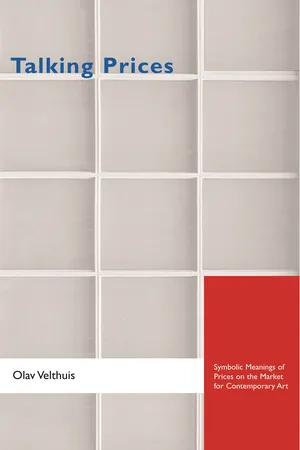
Talking Prices
Symbolic Meanings of Prices on the Market for Contemporary Art
- 288 pages
- English
- PDF
- Available on iOS & Android
About this book
How do dealers price contemporary art in a world where objective criteria seem absent? Talking Prices is the first book to examine this question from a sociological perspective. On the basis of a wide range of qualitative and quantitative data, including interviews with art dealers in New York and Amsterdam, Olav Velthuis shows how contemporary art galleries juggle the contradictory logics of art and economics. In doing so, they rely on a highly ritualized business repertoire. For instance, a sharp distinction between a gallery's museumlike front space and its businesslike back space safeguards the separation of art from commerce.
Velthuis shows that prices, far from being abstract numbers, convey rich meanings to trading partners that extend well beyond the works of art. A high price may indicate not only the quality of a work but also the identity of collectors who bought it before the artist's reputation was established. Such meanings are far from unequivocal. For some, a high price may be a symbol of status; for others, it is a symbol of fraud.
Whereas sociological thought has long viewed prices as reducing qualities to quantities, this pathbreaking and engagingly written book reveals the rich world behind these numerical values. Art dealers distinguish different types of prices and attach moral significance to them. Thus the price mechanism constitutes a symbolic system akin to language.
Frequently asked questions
- Essential is ideal for learners and professionals who enjoy exploring a wide range of subjects. Access the Essential Library with 800,000+ trusted titles and best-sellers across business, personal growth, and the humanities. Includes unlimited reading time and Standard Read Aloud voice.
- Complete: Perfect for advanced learners and researchers needing full, unrestricted access. Unlock 1.4M+ books across hundreds of subjects, including academic and specialized titles. The Complete Plan also includes advanced features like Premium Read Aloud and Research Assistant.
Please note we cannot support devices running on iOS 13 and Android 7 or earlier. Learn more about using the app.
Information
Table of contents
- Cover
- Title
- Copyright
- Contents
- List of Tables and Graphs
- Acknowledgments
- Introduction
- CHAPTER 1: The Architecture of the Art Market
- CHAPTER 2: Exchanging Meaning
- CHAPTER 3: Promoters versus Parasites
- CHAPTER 4: Determinants of Prices
- CHAPTER 5: The Art of Pricing
- CHAPTER 6: Stories of Prices
- CHAPTER 7: Symbolic Meanings of Prices
- CHAPTER 8: Conclusion
- Appendix A Interview Questionnaire
- Appendix B Description of Interview Sample
- Appendix C Record Prices for Art
- Appendix D Multilevel Analysis of Prices for Art
- Notes
- Bibliography
- Index